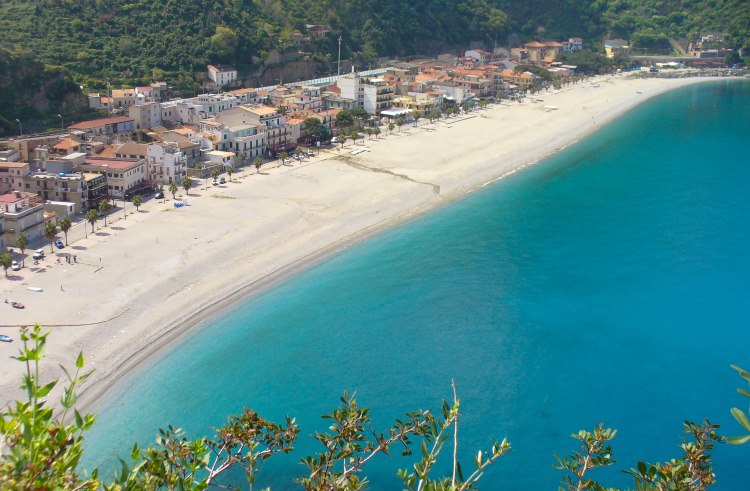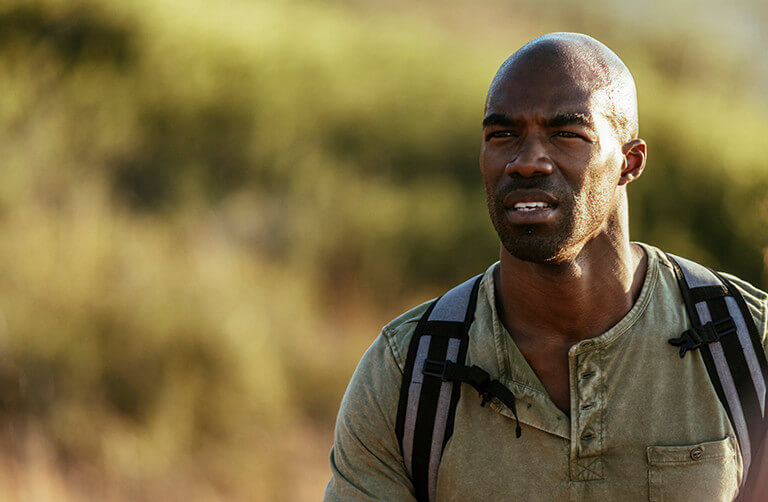Calabria, the toe of Italy’s boot, is more rustic – but no less captivating – than more popular regions up north, blessed with vast areas of wilderness and a gorgeous coastline. Nomad Olivia shares the best places to go.
 Photo © Getty Images / Nata Rass
Photo © Getty Images / Nata Rass
Calabria is Italy’s often-overlooked, wild, and mountainous toe. Less sophisticated, less la dolce vita than its northern neighbors, Calabria’s appeal lies in its rugged hinterland, shadowy history, and an impressively long coastline bathed by a cerulean-blue sea.
- Forests, mountains, and hilltop towns
- Down by the sea: Tropea and Scilla
- Bronzi di Riace in Reggio Calabria
- Trip notes
Forests, mountains, and hilltop towns
The Apennines form Calabria’s snaking, mountainous backbone, its wild interior dominated by three large national parks. As I drove towards the mountains of the Aspromonte National Park in the south, the rumored stronghold of the ‘Ndrangheta (the Calabrian Mafia), I felt I was heading for an adventure into the unknown. Instead of bandits and secrets, I found a landscape of forested slopes and pretty bergamot groves, steep twisting roads and hilltop eyries with stupendous views.
These fortified hilltop villages grew from southern Italy’s bloody history of successive invasions dating from ancient days. Some defy gravity, like the deserted village of Pentedattilo that clings dramatically to soaring rocky spires. Others, like Gerace, are medieval beauties with spectacular views of the Ionian Sea.

In the heart of Calabria, Sila National Park is a rolling green landscape, a massive mountain plateau with several picturesque lakes. The spring weather was perfect for hiking but “La Sila” is also popular for winter skiing.
As I zigzagged my way up Calabria’s spine, I stayed in rustic agriturismi, welcomed with home-cooked meals and tumblers of red wine. Calabria’s mountain people are as fiercely proud of their untamed land as they are of their hospitality, and none more so than in the Pollino.
Italy’s largest national park, the Pollino National Park, is a rocky, mountainous wilderness straddling Calabria and Basilicata. Once-isolated Albanian villages exist here, strangely suspended in time. Settled by Albanian refugees fleeing the Ottoman Empire between the 14th and 18th centuries, the villages maintain their Albanian language (actually a particular dialect of Albanian), dress, and customs.
Also unique are the famous pino loricato trees, ancient towering pines that only grow here and in the Balkans. I followed hiking trails beside deep river canyons, through dense forests of beech, fir and maple and across alpine meadows carpeted in wildflowers. I knew wolves and wild cats prowled the forest, but I sensed the Pollino was home to something far more ethereal and primal.

Down by the sea: Tropea and Scilla
As a self-professed beach connoisseur, I was lured to explore Calabria’s 500mi (800km) coastline, from the sandy eastern beaches lapped by the Ionian Sea to the dramatic rocky shores on the western Tyrrhenian coast.
The water along the entire coast is limpid blue and crystal clear – however, there’s a gritty feel to the long string of cheap summer resorts and ugly developments lining much of the coastline. It wasn’t until I reached the poetically named Costa degli Dei (Coast of the Gods) on the south-west coast that I found the seaside charm I was searching for.
Tropea, crowned Italy’s most beautiful village in 2021, perched on a cliff top overlooking a powder-white beach fringing the turquoise waters of the Tyrrhenian Sea. Legend names Hercules as the town’s founder, but its allure needed no celebrity endorsement. I strolled through the medieval town center, sampled a red-onion flavored gelato (a curious local delicacy), and gazed, bewitched, as a glorious rose-gold sun sank into the ocean.
A little further south on the Tyrrhenian coast, and just north of Reggio Calabria, Scilla vies for the title of Italy’s most beautiful village. According to Homer’s epic poem The Odyssey, Scilla was home to the mythical six-headed sea monster of the same name. Straddling a rocky promontory dominated by an imposing medieval castle, Scilla is divided into two parts. On one side, pastel-colored houses wind down the hill to a pristine sandy beach (safe now from monsters). But it was the old fishing port of Chianalea, with its jumble of stone houses and quaint restaurants lapping the seafront, that captivated me. I wandered down an enchanting maze of narrow alleys and cobbled laneways, stepping around fishermen mending boats and nets as they must have done for centuries. As evening fell, the village was transformed into a romantic, lantern-lit seaside enclave.

Bronzi di Riace in Reggio Calabria
In Reggio Calabria’s national archaeological museum, the Museo Nazionale della Magna Grecia, I found perfection. The life-size bronze statues of two naked warriors, the magnificent Bronzi di Riace, are the world’s finest examples of ancient Greek sculpture. I couldn’t tear my eyes away from their stunning physiques and handsome, bearded faces. Were they gods or men?
The bronze warriors, dating from around 450 BC, were found in relatively shallow water off Riace on Calabria’s Ionian coast in 1972. As the region was once part of ancient Magna Grecia (Greater Greece), it is believed they were shipwrecked during transport. But where were they going? And where did they come from? Nothing more is known about them. Their story remains a mystery.
Other than a lively and pretty seaside promenade – which overlooks the Strait of Messina – there’s not much to see or do in the main port city of Reggio Calabria. But it’s worth a visit simply to gape and marvel at the exquisite Bronzi di Riace.
Trip notes
Lamezia Terme airport, south of Cosenza, has domestic and international flights. Reggio Calabria has a small domestic airport and a train station with services running to Rome, Milan and Naples. However, the best way to explore Calabria is to hire a car. There’s a decent autostrada (Autostrada del Sole) along the west coast and most interior roads are well signposted.
An agriturismo (the plural is agriturismi) is accommodation on a working farm and can range from a single room to an entire farmhouse. In urban areas, B&Bs have become more popular than hotels and cover a wide range of options from seaside bungalows to restored palazzi, with prices to match.
Calabria’s Mediterranean climate makes it a year-round destination. From April to June, spring wildflowers entice hikers, beachgoers bake in the sun during the summer party months of July and August, while March and October see mild weather and fewer crowds.
Discovering this region is an adventure and it’s handy to know a smattering of Italian if you want to delve into its secret places.
Related articles
Simple and flexible travel insurance
You can buy at home or while traveling, and claim online from anywhere in the world. With 150+ adventure activities covered and 24/7 emergency assistance.
Get a quote


5 Comments
Pls when can I fill the application form for coming down to Calabria in order to stay and do business for many years?
Jan. 7th.
My fianceé lives in Calabria & has shower me photos of the are. What she's shown me is sub living standards. The REAL Calabria.
The roads are narrow & most are one way, most roads r filled with huge pot holes & the locals fill them with rubbish as the council won't repair them. Next is the town's water, u can't drink from the kitchen tap as it's highly contaminated with rust & other variants. The town's population has to buy bottled water OR drive to the town center with their containers to fill them up.
The medical centers u don't ring for an appointment u just go & sit in tiny waiting rooms till it's yr turn & hope for the best.
The domestic bins u have r knee high & meant to put out every day yet the rubbish collectors don't collect for days or weeks thus people dump their waste on the streets piling up up to 2 meters high or more & attracting rats etc.
Unless u have money yr house or flat doesn't come ready to move in.
U have to supply your own kitchen your own stove your own kitchen sink & that's just a start. The law is corrupt & unless u know someone higher up on a personal basis u DON'T get anything done. This my friends is the REAL Calabria that u often don't hear or see. I've see all these so called travel links saying how beautiful Calabria is but it's all show.
Hope what I've highlighted here will shed some light on all that want to travel there.
Hope all are well.
Ciao per adeso.
I would definitely be the happiest to explore that many areas. To see the landscapes/geographical, nature, the people, different cultures, food, to learn the language, etc would give excellent content writing or excellent story to tell.
I would love to travel Different places to learn more about Culture, Languages and the Nature as I'm a Novel Writer that can help me more on my writing Content as I explore the world it's my Dream to lean the Diversity of our Uniqueness as Humans and Nature I love that I can write plenty of books with that experience ..
Howdy! This is often kind of off subject but I need some assist from a longtime blog site. Can it be tough to set up your own private site? I’m not extremely techincal but I can figure factors out very speedy. I’m pondering generating my very own but I’m undecided the place to begin. Do you may have any ideas or strategies? Many thanks